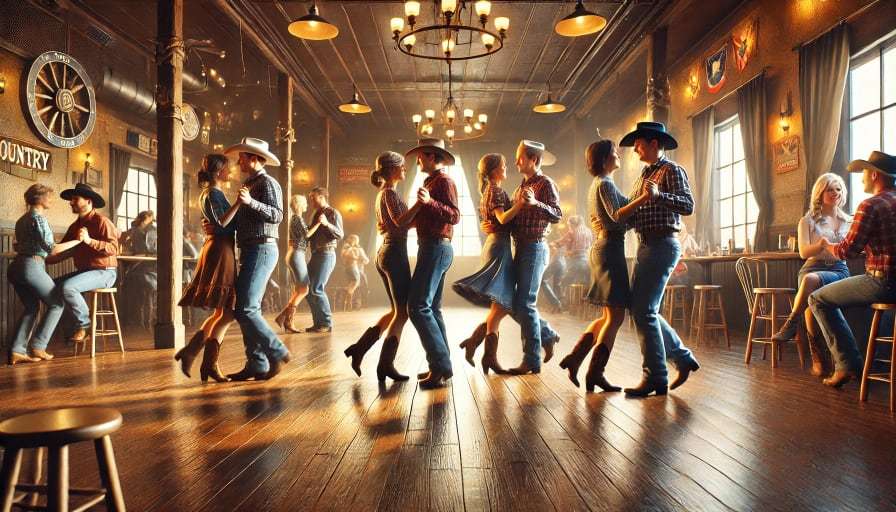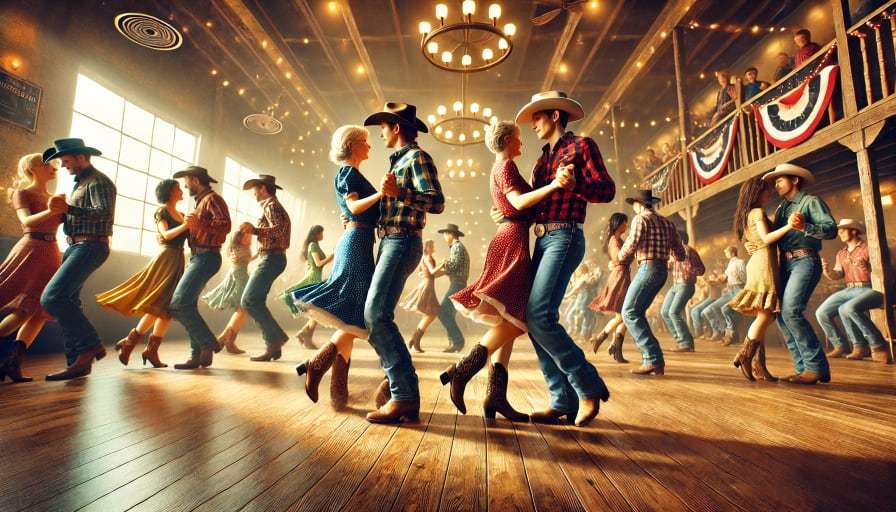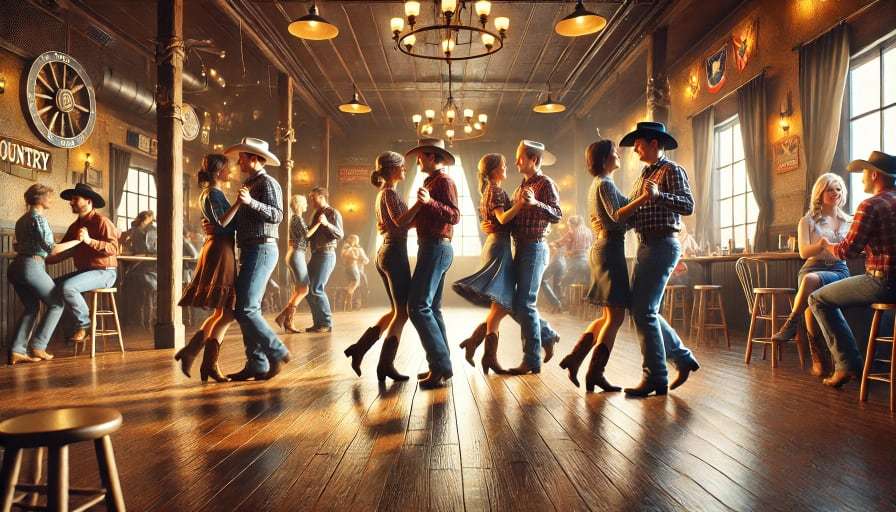Beginner Line Dancing Guide: Steps to Fun in Brown County

Beginner Line Dancing Guide: Steps to Fun in Brown County
Two left feet? No problem. This beginner's line dancing guide will take you from wallflower to confident dancer. If the Electric Slide or the Boot Scootin' Boogie seem intimidating, fear not.

I'm a certified dance instructor, and you'd be surprised how many people think they can't dance. Trust me, with a bit of practice and the right beginner’s line dancing guide, anyone can enjoy this fun, social activity. I see it every weekend at Mike's Dance Barn here in Nashville, Indiana.
Table of Contents:
- Beginner Line Dancing Guide: Understanding the Basics
- Where to Learn Line Dancing
- Popular Line Dances for Beginners
- Line Dancing Etiquette
- FAQs about beginner line dancing guide
- Conclusion
Beginner Line Dancing Guide: Understanding the Basics
Line dancing isn't just for cowboys and country music fans, although it originated with folk dances hundreds of years ago. Now danced to pop, rock, and even Latin music, you'll find line dances everywhere from weddings to clubs.
It's all about performing choreographed dance steps in a synchronized manner, often in lines or rows. While line dancing involves set steps, there's still room for personality.
You can add your own flair with arm movements or a little extra hip action. Having a good time is key.
Types of Line Dances

There are different formations in line dancing based on “walls,' which refers to the direction dancers face:
- One-wall: Everyone faces forward.
- Two-wall: Dancers alternate facing the front and back.
- Four-wall: Dancers turn to face each wall throughout the dance, making it trickier for beginners.
Basic Line Dance Steps
Mastering the following basic dance steps gives any beginner dancer a head start on any dance floor. Try practicing these basic steps to a dance song of your choice. They're pretty easy.
| Step | Description |
|---|---|
| Grapevine (Vine) | Step to the side, cross behind, step to the side, touch/brush/kick your other foot. This step sequence can travel to the right or left. |
| Weave | Similar to the Grapevine step, but you step over rather than to the side: cross over, step back, cross under, step to starting position. |
| Scoot | Slide your weighted foot (forward, backward, or sideways), raising your other leg with bent knee. Picture a horse prancing. |
| Brush | Sweep your free leg forward or back, brushing the ball of your foot on the floor (heel raised). |
| Kick | Lift your leg in any direction, with a slight bend at the knee (no full extension). |
Where to Learn Line Dancing
Plenty of resources are available for learning how to line dance. Both in-person and online options cater specifically to newcomers.
Line Dancing Classes
Taking a line dancing class is a great option, particularly for someone brand-new to the style. You'll meet fellow newbies, create a fun learning atmosphere, and practice with others at a similar skill level.
Look for dance classes near you.
Online Dance Classes
For the more hesitant beginner, online classes can be an easier entry point. Many online resources provide step-by-step instruction, allowing you to learn at your own pace from the comfort of your living room. The best line dance lessons online offer private classes through services like TakeLessons Live.
Social Settings
Dive headfirst into a honky-tonk. Many places, including clubs and weddings, offer excellent line dancing opportunities.
It’s essential to pick somewhere you feel comfortable and watch before diving in. Be aware of established floor etiquette. Just keep in mind the rules may be a bit different depending on venue-specifics.
No matter where you choose to learn, have fun and enjoy the process.
Popular Line Dances for Beginners
When starting your line dancing journey, try well-known dances like the Cupid Shuffle or Electric Slide. These are great beginner dances.
Cupid Shuffle
This dance’s claim to fame lies in its simple, repetitive steps. This makes memorization almost automatic. The Cupid Shuffle is often played at parties because of its universal accessibility, regardless of background.
It creates instant community vibes. People even request line dance instruction to perform the Cupid Shuffle together during wedding festivities. The step instructions call out directions throughout the dance.
Electric Slide
Originating in 1976 and made famous with 1989's recording of Marcia Griffiths’ “Electric Boogie,” this dance has achieved lasting fame. The Electric Slide consists of easy combinations of Grapevines, rock steps, and quarter turns. It is super fun.
Line Dancing Etiquette
To maximize enjoyment, it's important for everyone on the floor to have mutual respect. This begins with following some standard norms in country line dancing etiquette.
- Start in the center of the floor if you are less experienced, to provide ample space for progression unless you are already familiar with the routines. This space also suits line dances.
- Move outward into the peripheral spaces of the circle's outer rim clockwise once you gain confidence in the steps.
- Avoid excessive movement, especially in the midst of turns. Consider all participants moving together as a collective; each piece is significant, so awareness of yourself within the whole and your fellow dancers becomes equally important.
- Acknowledge other dancers when collisions inevitably occur. No one functions perfectly on a floor with several others moving in multiple directions, even with a similar beginner line dancing guide. Some dancers may have experience with certain styles.
- Stay mindful that during rotations, attention is required on the floor area directly underfoot. Avoid moving significantly when doing turns for optimal safety awareness. Then resume the dance steps.
- Step out from center-stage if you need a momentary break. Pause only long enough to regain your awareness before joining in again so the dance remains continuously enjoyable until the very end.
FAQs about beginner line dancing guide
What is the easiest line dance for beginners?
The Cupid Shuffle and the Electric Slide are generally considered the easiest, thanks to their simple, repetitive steps and helpful song cues. They are beginner line dances for a reason. Both are easy to learn.
Can you teach yourself to line dance?
Yes, especially with online resources and videos. However, classes can offer personalized feedback and a social learning environment, boosting both enjoyment and success. Line dancing classes in your area could provide helpful support.
Is line dancing a good way to lose weight?
Absolutely. It's a fun, low-impact cardio workout that burns calories and tones muscles. Plus, the social aspect adds to the enjoyment. The dance steps can elevate your heart rate too. This combines exercise with social interaction which helps with mental well-being as well.
How do you memorize line dance steps?
Start by breaking down the dance into smaller sections. Practice each part until it feels natural, then combine the sections.
Visualizing the steps, or saying them aloud as you practice, also helps with memory. You can also use written dance step sheets that visually lay out the order, name, and pattern of the steps. It may be good to do this in your living room to practice.
Conclusion
So there you have it: your new beginner’s line dancing guide. With this, and a healthy dose of enthusiasm, I expect to see some killer moves from you soon. For any dancer, even with a beginner’s line dancing guide, the goal is to focus on foot placement first. As you improve, incorporating style becomes something enjoyable with every move.
Over time, practicing improves accuracy. What was once difficult becomes almost automatic, like a pivot turn. From there, what started stiff now appears effortless. Even experienced dancers using a step sequence sometimes discover newer areas which feel awkward at first. Everyone has to start somewhere.
This newfound skill will be easily recalled at every wedding, or similar group opportunity where country dancing songs are played. Line dancing is super fun. It is easy to learn and you can have a good time while line dancing.
Check out our products page!

